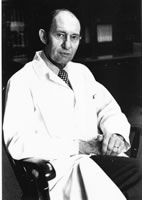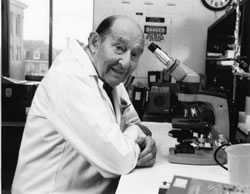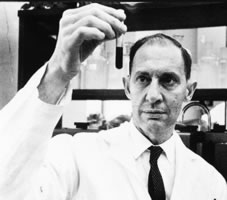Dr. Gerson is Director, Case Comprehensive Cancer Center; Director, Ireland Cancer Center; and Director of the Center for Stem Cell and Regenerative Medicine, Case Western Reserve University and University Hospitals Case Medical Center.
Dr. Berger is Hanna-Payne Professor of Experimental Medicine; Professor of Medicine, Biochemistry and Oncology; and Director of the Center for Science, Health, and Society at Case Western Reserve University School of Medicine.
Oscar D. Ratnoff, MD, we might presume, stood in his office in late 1964 with his biochemist colleague, Earl Davie, at Case Western Reserve University and in a moment of chalkboard brilliance, devised the coagulation waterfall, published later that year in the journal, Science. His observations, along with those of Robert Macfarlane, also published in 1964 in Nature, provided the guiding light for research and education into the clotting process for decades to come. Dr. Ratnoff, by his own hand, used painstaking efforts to partially purify clotting factors, and then used blood products from patients with deficits in one or more factors to establish mixing experiments and deduced the complexity of blood clotting by simple glass tube experiments timed with a stopwatch. For those of us lucky enough to have laboratories nearby, we watched patients come to his research office, and we provided countless blood samples as healthy donors until we turned 40, at which time he recognized that our own clotting waterfalls became more complex and were perhaps not suitable as controls.
The son of a New York general practitioner, Dr. Ratnoff was trained, first at Columbia College of Physicians and Surgeons, then at Johns Hopkins, Harvard Medical School, and Montefiore Hospital in New York, before coming in 1952 to what are now Case Western Reserve University School of Medicine and University Hospitals, Case Medical Center. Dr. Ratnoff was excited about pursuing laboratory research and investigating patient problems, usually with synergism. He was a paragon of translational research before the term was ever popularized. While he served as chair of hematology and interim chair of medicine, he much preferred his laboratory and clinical practice, taking greater pleasure with residents and fellows, all of whom had productive experiences in his laboratory.
Dr. Ratnoff had a prepared mind when John Hageman, MD, came to his lab for evaluation of an asymptomatic prolonged glass tube clotting time. [A correctioncorrection was later issued to this article regarding John Hageman.] This led to his discovery of Hageman factor (Factor XII), which helps to initiate clotting on a glass surface but was not required to form a clot in vivo. This finding and other studies with partially purified factor preparations in plasma led to the hypothesis that a clot formation consisted of a series of inactive factors or zymogens activated in sequence, dubbed a waterfall sequence, and that the balance of clotting in the body was mediated by factor levels and initiators of the clot. Although deciphering the complexity of these initiating factors remains an active area of research, Dr. Ratnoff clearly recognized the impact of illness and age, perhaps explaining why Dr. Hageman died of a pulmonary embolus and why he did not want those over 40 years of age considered for collection of normal plasma or the study of vascular abnormalities as mediators of clotting initiation. Later, with Hidehiko Saito, MD, this approach led to the discovery of Fitzgerald factor, also associated with prolonged clotting times, and then, together with Virginia Donaldson, MD, they identified Fitzgerald factor as high-molecular-weight kininogen, thus linking clotting to inflammation.
Dr. Ratnoff and his colleagues, including residents and fellows, continued in their efforts to understand patients with other evidence of defective clotting, including von Willebrand disease. While the elucidation of the relationship between von Willebrand factor and factor VIII proved to be complicated, Dr. Ratnoff's development, with Ted Zimmerman, MD, of an immunoassay to differentiate classic hemophilia factor VIII from von Willebrand factor provided a critical tool to distinguish and characterize the two disorders.
Later, as a result of his drive to let no clinical puzzle go uninvestigated, Dr. Ratnoff described psychogenic purpura, typically seen in women with some level of hysterical mood disorder, who have self-inflicted bleeding of unclear etiology and clinical course. Perhaps one of the greatest public health impacts that Dr. Ratnoff's work has had was his decision to boldly proclaim that the blood supply, especially preparations of factor concentrate, should not be used because it had been contaminated with HIV from the donor pool of the early 1980s. With Mike Lederman, MD, he identified hemophilia as a risk factor for AIDS when he noticed first a drop in lymphocyte counts among his patients with hemophilia, and then their propensity to opportunistic infections associated with impaired cell-mediated immunity and the occurrence of "immune" thrombocytopenic purpura. As a result, he strongly advocated for use of cryoprecipitates from selected, screened donors.
Through all of these endeavors, Dr. Ratnoff has cherished his role as educator, research preceptor, and article reviewer. For those of us so lucky, receipt of his erudite reviews of what we considered our final drafts, strewn with corrections marked in red ink, was a sure sign of an acceptable manuscript submission, pending grant award, or academic promotion statement. We also remember his stern disdain for the term "complete remission," his 10-line rule for assuring a slide's legibility and impact, and his love of preparing fellows for presentations at scientific meetings. Dr. Ratnoff, like many of his generation, is guided by the principle of academic medicine in its purest sense, of handwritten notes and personal observations. No one could escape his infectious enthusiasm, when Dr. Ratnoff ran down the hall showing everyone his latest lab results drawn out on green graph paper. He instills in his colleagues a love of discovery and a care for a well-crafted spoken and written phrase. Above all, he brought logic and order to a coagulation field mired in complex observations and laid the foundation for today's research advances in the field.




